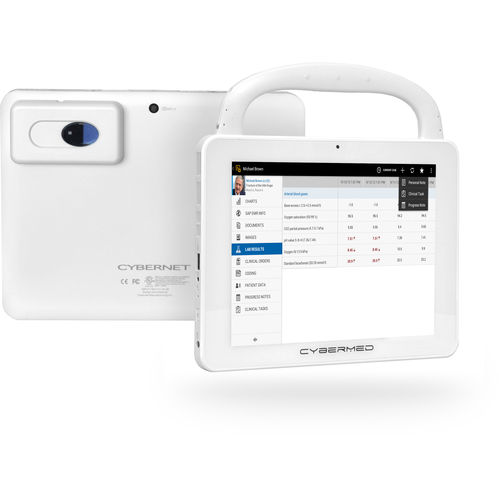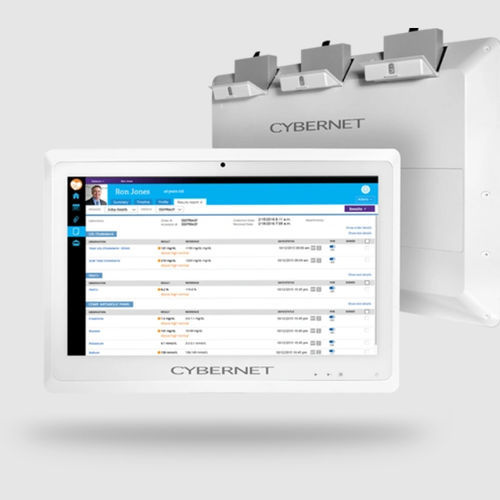
#Product Trends
USB-C: THE UNSURPASSED CONNECTOR FOR MODERN MEDICAL COMPUTERS
Making connections simple in healthcare
Looking at the back or sides of your hospital’s medical computers can reveal a dizzying array of ports and plugs, and all meant to interface with other devices and help you better treat your patients. In recent years, you may have noticed a new addition to this gathering of ports: a small, unassuming oval shape.
This new shape is for the USB-C connector, the latest type of USB system. USB, or universal serial bus, has been the industry standard for computers, electronic hardware, and peripheral devices since 1995. USB ports were designed to replace older types of ports like serial, parallel, and game ports and are most frequently used to enable devices like mice and keyboards to work with a computer. Because USB is the industry standard, it also allows users to switch from one device to another, even if they come from different manufacturers, so long as the USB connectors match.
USB-C: The Latest in the USB Series
USB-C has a symmetrical connector with 24 pins. It can be rotated and works regardless of orientation. The 24 pins transmit data, power, and signals between devices.
Rotational symmetry: If you’ve ever tried to plug in a USB cable before, you’ve almost certainly had that experience where the plug won’t fit in, forcing you to turn it over and try again. USB-C, however, is rotationally symmetrical, meaning it has no “up” side or “down” side. As long as the plug is correctly aligned with the port, it will plug in without a problem.
24 connector pins: The connector pins, as their name implies, connect with matching pins on the other device to transfer data and power. The USB-C features 16 data transfer pins, 4 power pins, and 4 grounding pins. For comparison, the USB-A 3.0 connector only has 9 pins: 6 for data, 1 for power, and 2 for grounding.
Advantages of USB-C In General
The USB-C connector system is a modern and advanced technology that offers numerous benefits over its predecessors. It provides faster data transfer rates, supports higher power delivery, and offers a reversible design for easier connection. Additionally, the USB-C connector is versatile and compatible with many devices, making it a popular choice among tech-savvy users. These advantages include:
Symmetrical Design: Unlike older USB ports, there’s no right side to worry about when plugging in. This feature is incredibly convenient for plugging into areas already crowded with other plugs and wires or when the port is difficult to reach.
Speed: USB-C plugs feature more data transfer pins than their predecessors, meaning they can upload and download data much faster. A standard USB-C connection can transfer 10 gigabytes of data per second over a 1-meter-long cable. By comparison, most USB-A connectors max out at 5 gigabytes per second.
Power transfer: USB-C’s greater number of power pins makes it a great way to recharge or power other devices, such as medical tablets, RFID readers, phones, and more.
Small size: USB-C is only half the width and one-third the height of USB-A, making it easier for manufacturers to fit the port on the device.
Flexibility: USB-C plugs can still work with older devices that don’t have USB-C ports by using the appropriate adapter, allowing for backward compatibility.
Why Use USB-C on Medical Computers
In the specialized field of medical computers and devices, there are several reasons why USB-C is a superior connector system. These reasons are:
Symmetrical Design: This feature was already mentioned, but it bears repeating. USB-C’s most significant advantage for healthcare IT professionals, or anyone who has to plug and unplug their device repeatedly throughout the day, is that the plug can be inserted both ways without worrying about damaging the connector itself.
Multipurpose: The USB-C connector is a highly versatile port that simultaneously transmits data and power signals through a single cable. The port eliminates the need for multiple cables and is especially useful for modern devices, such as laptops, tablets, and smartphones, often with limited ports. Using USB-C, devices can conserve space and reduce clutter by eliminating the need for separate power and data cables. In addition, USB-C is designed to carry much more power than previous USB standards, which allows it to charge devices more quickly and efficiently. Overall, the USB-C connector significantly improves over older USB standards, offering greater efficiency, convenience, and versatility for various devices. Hospitals often use legacy equipment reliant on older and larger serial ports, which lets the computer work with old and new equipment.
Faster speed and higher bandwidth: USB-C enables higher data transfer rates between a device and the medical computer, making it perfect for high-stakes tasks such as in the operating room. In an environment where seconds can be the difference between life and death, surgeons can’t afford to wait for data from their instruments to finish downloading.
Supports alternate modes: USB-C connectors offer the additional benefit of supporting various data forms, including serving as a display port output. Medical monitor users can have multiple video outputs, enabling numerous individuals to view the same data using different screens.
These factors combined make it easy to see why USB-C is becoming a standard choice to include on medical PCs.
Closing Thoughts
The ongoing march of progress naturally includes taking advantage of the newest and best connectors. If your company or hospital is interested in medical computers with USB-C connector ports, contact us here at Cybernet Manufacturing. Our expert staff are happy to explain the advantages of our medical PCs and tablets.








